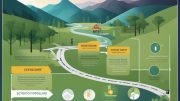In my career I have always worked in the GIS department; where that department sits within the company has varied from business to business. I have worked at companies where GIS has been a separate entity. I have worked where GIS has been part of the Engineering and Design Division. I have worked as a user in another department outside of GIS supplying them with data in a particular format for service. I have worked where GIS has been part of the Information Technology (IT) staff. This situation, outside of a separate GIS department to me is the next logical and best conclusion.
Ideally the preferred situation is for GIS to be its own department with staff filling the support roles needed to run a successful GIS application for employees to use. This would include a specialist, technician, supervisor, and programmer.
Most of the time this is not feasible for budgeting in an organization. It is more cost effective to transfer some of these roles to another department and have what is known as a GIS power user or subject matter expert (SME) who can act as an all-around “jack of all trades” and interpreter for staff in other departments. Examples include support from the IT department to help ensure everything runs effectively and managing any SDE or internal database applications while Engineering supplies the data for conversion. (Some of y’all know all too well this scenario)
In my humble opinion, I prefer to be a GIS person working in a GIS Department but nowadays it seems like GIS is being pushed more and more to the IT department, through no fault of the user but by way of the application design and its future and potential uses. As mapping applications become more accessible and easier to use it seems like everything is moving to more of an IT role. The only real scenario where this kind of support is not required is in a small company using standalone licenses and creating flat shapefiles; or maybe for an advanced user, a geodatabase.
As companies move to offer ArcGIS Server to administer their data to ensure integrity by having everyone looking at the same thing, it really does move in the direction of IT knowledge, skills, and abilities. I mean let’s face it, to the average GIS user all the background work sounds like a war zone. You have de-militarized zones (DMZs), federated servers and security protocols. You just want to make some useful data to share with everyone right? It only seems logical that this department would naturally step up into the role of administering data and servers, that’s what they already do. The days of standalone desktops and flat files are coming to an end and quickly.
The next generation of GIS users will have to know more than just how to select, edit or create shapes. The GIS industry is moving more into the internet zone and as it does its users must learn these skills and work within the IT department to deploy the resources needed to keep up with the advancing technology of GIS. Ultimately in this scenario this puts the data editing back into the data owners’ hands and allows the GIS specialist, manager, etc. to focus on maintaining the integrity and application of the data such as database administration, mapping, and web applications.
[poll id=”2″]






This “where does GIS belong?” debate and the age old IT vs GIS paradigm will probably be debated or discussed for years to come. I have written a couple articles about it and then put them on the shelf, last year I did a conference paper on it but it wasn’t accepted. It’s a slippery slope. Often there are politics at play, ego, power and control, and major budgetary issues. Given that this OG space is a bit industry specific I would say that we will never define a best practice. I think GIS folks gravitate towards those most like them, ie techie folks, we also need server access, permissions and rights – those are easier to get when you are “part of them”. The folks in the business side rarely really know what you do, how you do it or why. They just know that it involves IT and it’s lost on them so therefore…. You must be IT. That said, what are some of the cons? IT is a cost center, not a profit center, they are budget constrained and most likely hate having GIS ride on their financial coat tail. You are still the red headed step child in IT, you never really will be on par with the system engineer or dba, they know that and you know that….so you end up with a crappy office, minimal respect and minimal input. There are others but I will slow my roll. I think GIS folks do a really poor job of educating others on what they do, how they do it and why, as well as on the financial benefits (ROI) of having a successful GIS program. We also have done a horrible job of advocating and of being ambassadors within IT departments. We need to make sure that folks understand why file access, local admin rights or DB permissions are vital to your job, we need to build trust with the IT folks – not just toss in the towel and proclaim that if you can’t beat them, join them. Gotta run.
Aaron,
Thanks for sharing your thoughts, they are very much food for thought for the GIS professional in today’s industry and great advice. I agree that advocating and articulating what we actually do is vital to integration. Cheers, Shyla